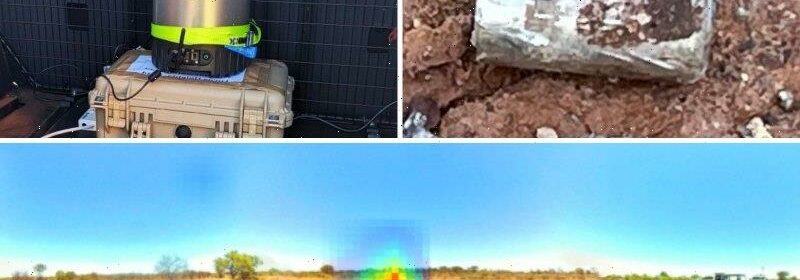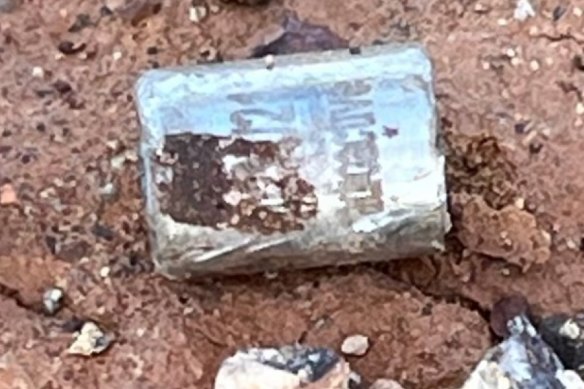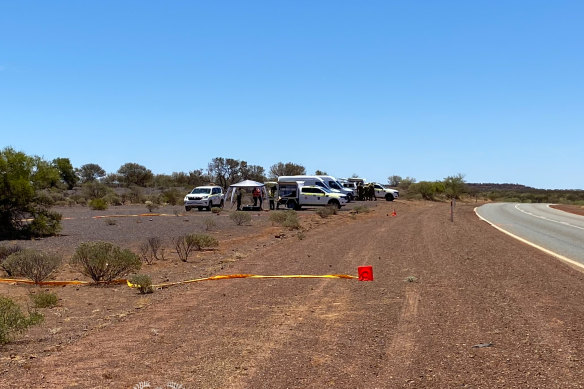The inside story of how WA’s tiny missing radioactive capsule was found

By Hamish Hastie
The tiny radioactive capsule was run over but its ceramic casing was not damaged.Credit:DFES
As the 40-degree heat belted down on Western Australia’s Pilbara at 11am on Wednesday morning, a strange two-car convoy slowly travelling south on one of the state’s longest roads came to an abrupt halt.
Leading the convoy was a Toyota Prado driven by Australian Nuclear Science and Technology Organisation scientists, one of whom was closely monitoring cutting-edge radiation detection technology installed in the hire car the day before.
Behind them was a Department of Fire and Emergency Services vehicle, protecting the Prado from road trains as they drove 40 kilometres an hour under the speed limit during the now globally famous hunt for a tiny radioactive capsule lost in the WA outback.
Just a few hours into their first shift, about 74 kilometres south of the Pilbara mining town of Newman, the scientists heard a beep.
“Everything spiked and the computers went mad and they hit the brakes and flew out of the vehicle in excitement,” the head of the search efforts Darryl Ray said.
The hunt was over.
A missing capsule, a frantic search
WA authorities believe the 8 millimetre-long and 6 millimetre-wide silver capsule fell out of a bolthole in a radiation mining gauge, then out of a wooden crate, and finally off the back of a truck around January 12.
When the capsule was jettisoned from the truck it was just 230 kilometres into its 1400-kilometre journey along the Great Northern Highway from Rio Tinto’s Gudai Darri iron ore mine to its final stop in an industrial area in Perth’s northern suburbs.
The capsule contained the harmful radioactive substance caesium-137, which WA Health warned emitted the equivalent of 10 X-rays worth of radiation every hour to a person standing close to it. Easily enough to cause serious radiation sickness with prolonged exposure.
The public health risk was deemed low, but there were concerns the capsule may have lodged in someone’s tyre and gone on a merry journey to anywhere in the country. Worse still, the capsule could have been damaged and be leaking far more harmful levels of radiation into the environment.
Its disappearance wasn’t noticed until January 25 when the equipment was unpacked. Radiation safety protocols were followed and DFES, WA Police and WA Health were notified shortly after.
By January 27, it dawned on authorities that the capsule could be anywhere along the 1400-kilometre route (the same distance as Brisbane to Melbourne), so the public was alerted in a hastily arranged Friday afternoon press conference. It was around this time that DFES also put the call out to the rest of the country for help.
DFES calls for backup
Over the weekend ANSTO, as well as the Australian Defence Force and the Australian Radiation Protection and Nuclear Safety Agency answered the call.
All three agencies quickly tested and packed their specialised radiation detection equipment and from Monday teams began assembling and scouring stretches of the Great Northern Highway, as well as some Perth roads where it was thought the capsule could be.
By Wednesday morning seven teams had joined the hunt, including three ANSTO teams; two based in Perth and one in Newman.
Before this week, the public may have had no idea about ANSTO’s existence but the publicly funded nuclear science research organisation has been toiling away for 70 years inventing new technologies.
They also had the perfect device to search for the capsule – the CORIS360 – which was invented by ANSTO’s own chief technology officer, David Boardman.
According to ANSTO the CORIS360 “produces fast, precise and high-quality 360-degree images that pinpoint the identity and location of radiation in an area”.
On Saturday, the Sydney-based scientists had determined the CORIS360 was up for the job with a few modifications and could even pinpoint caesium-137 over other radiation common in the WA outback from sources such as uranium.
ANSTO nuclear safety, security, and stewardship boss Miles Apperley said the scientists tested the CORIS360 in Lucas Heights, south-west of Sydney, before heading to Perth.
Authorities at the area where the capsule was found in Western Australia’s remote Pilbara region.Credit:DFES
“Prior to deployment, ANSTO staff performed drive-by test runs of the detection equipment at Lucas Heights using an equivalent radioactive source activity, and evaluated different speeds and terrain conditions to ensure we could confidently detect the missing capsule,” he said.
“The sensitivity of the modified CORIS360 technology gave us the confidence it would be found.”
They flew to WA on Monday. The Newman team didn’t arrive in the Pilbara until Tuesday night, but they didn’t waste anytime getting to work on Wednesday morning.
Caesium closed
Ray, a level-headed assistant commissioner at DFES, was in his agency’s regional operations office with three other people when the call came through that the capsule had been found two metres off the side of the Great Northern Highway.
Despite this good news, his small team had to keep it a secret for four hours as work began to recover the capsule.
“The sensitivity of these devices, there was without a doubt that if it was there, we were going to locate it.”
“We took control of the scene, set up a hot zone, controlled the entry. We verified the source with three different pieces of equipment,” he said.
An hour south, a defence force team was also involved in the search heading north along the Great Northern Highway.
Ray said the defence team had the correct equipment and the right training to handle the capsule, so they waited for them to arrive before going near it.
“They took over the recovery, they entered the hot zone, they picked the device up, verified the number because the … serial number was facing down,” he said.
He said the capsule appeared to have been run over during its few weeks of freedom, but the sturdy ceramic casing was not damaged.
Ray said time and distance were their friends when it came to radiation so during the four-hour recovery no single person spent much time near the capsule until it was placed in a lead box known as a “pig”.
“They restricted the amount of time that somebody was near it to be able to turn it over and near it to take a photo and near it to pick it up,” he said.
The capsule was then taken to Newman for a storage under defence guard before it made its way back to Perth on Thursday with an escort of about 14 defence force and ANSTO personnel, where it is now being stored in an undisclosed location before its fate is decided by the WA government.
Neither Ray nor the scientists involved in the search were surprised that the capsule was found so easily.
Bronte Sial is a senior consultant health physicist who was part of one of the Perth ANSTO teams.
She said the testing before they left Sydney confirmed that if the capsule were near the road, they would find it.
“I was very confident in everyone’s capability, the only worry was if the information hadn’t been correct, then maybe we wouldn’t have been able to find it,” she said.
“But the sensitivity of these devices, there was without a doubt that if it was there, we were going to locate it.”
So who pays, and how do we stop this happening again?
The WA government has already started looking at beefed-up fines for the incorrect storage or transport of radioactive material which, as the current legislation stands, would only cost the organisation at fault $1000.
Chief Health Officer Andy Robertson, who is also chair of the WA Radiological Council, is leading an investigation into the incident which he said would take weeks to finalise.
Centurion, the trucking company that transported the equipment, and SGS, the company packed it, are all adamant they followed the book in their handling of it.
Rio Tinto’s iron ore chief executive Simon Trott has apologised several times for the debacle and has offered to reimburse the WA government for the search.
How the highly radioactive capsule would have looked like through the eyes of CORIS360.Credit:ANSTO
Ray said he didn’t know what those costs were yet but with at least 60 WA government staff involved in the search, he expected it would likely be in the tens of thousands of dollars.
However, he said the cost didn’t even enter his mind during the search, which was only focused on finding the capsule.
Sial was thrilled when she found out her colleagues had found the capsule. There were “hugs all around”.
After his successful day that made global headlines, Ray celebrated in his own way by watching an episode of Survivor.
The Morning Edition newsletter is our guide to the day’s most important and interesting stories, analysis and insights. Sign up here.
Most Viewed in National
Source: Read Full Article


